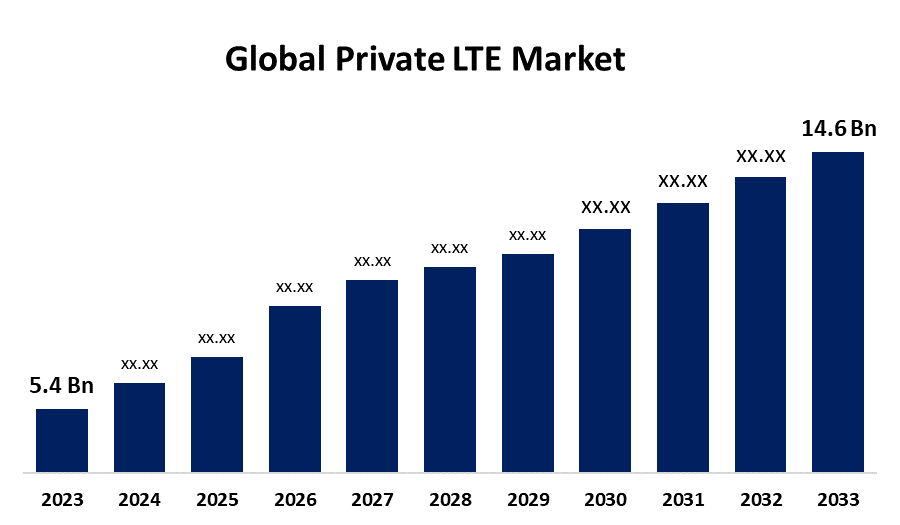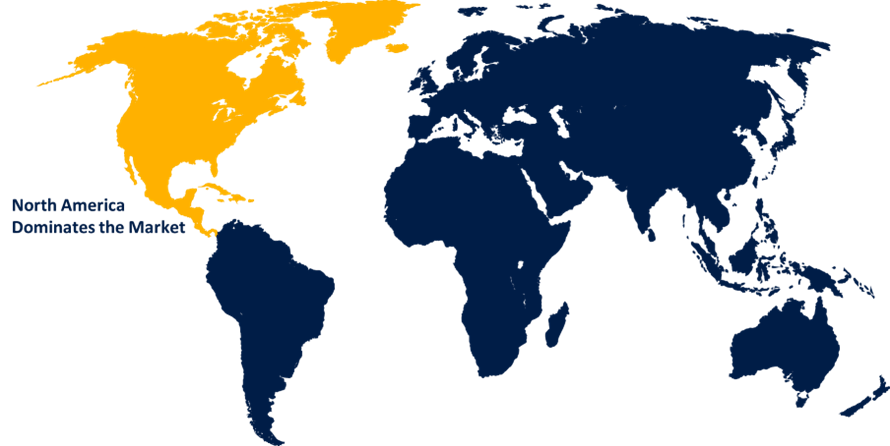Global Private LTE Market Size, Share, and COVID-19 Impact Analysis, By Component (Technology (FDD & TDD), Services (Managed Services, Professional Services), By Application (Public Safety, Logistics & Supply Chain Management and Asset Management), and By Region (North America, Europe, Asia-Pacific, Latin America, Middle East, and Africa), Analysis and Forecast 2023 - 2033
Industry: Electronics, ICT & MediaGlobal Private LTE Market Insights Forecasts to 2033
- The Global Private LTE Market Size was Valued at USD 5.4 Billion in 2023.
- The Market Size is Growing at a CAGR of 10.46% from 2023 to 2033.
- The Worldwide Private LTE Market Size is Expected to Reach USD 14.6 Billion by 2033.
- Europe is Expected to Grow the fastest during the forecast period.

Get more details on this report -
The Global Private LTE Market Size is Anticipated to Exceed USD 14.6 Billion by 2033, Growing at a CAGR of 10.46% from 2023 to 2033.
Market Overview
Private long-term evolution (LTE) is a cellular network system that offers individual network services independent of any carrier. It consists of hardware, mobile core software, subscriber identification module (SIM) cards, and network orchestration software that can be customized to meet the unique needs of an individual or an enterprise. Private LTE uses localized micro towers and small cells to improve connectivity, modify applications, and reduce network latency. In contrast to public LTE, private LTE operates on dedicated equipment and provides independent coverage, security, and performance. As an outcome, private LTE has numerous applications in a variety of industries, including education, healthcare, manufacturing, oil and gas, energy and utility, retail and e-commerce, information technology (IT), and telecommunications. Furthermore, significant growth in the global telecommunications industry is one of the key factors contributing to the market's positive outlook. Private LTE increases bandwidth and data transfer speeds, preventing unstable internet connections during video and audio calls. Also, widespread product adoption in smartphones and smart home devices, such as security alarms, connected city streetlights, smart waste management, and wearable fitness and health trackers, is driving global private LTE market growth.
Report Coverage
This research report categorizes the market for the global private LTE market based on various segments and regions forecasts revenue growth and analyzes trends in each submarket. The report analyses the key growth drivers, opportunities, and challenges influencing the global private LTE market. Recent market developments and competitive strategies such as expansion, product launch, and development, partnership, merger, and acquisition have been included to draw the competitive landscape in the market. The report strategically identifies and profiles the key market players and analyses their core competencies in each sub-segment of the global private LTE market.
Global Private LTE Market Report Coverage
| Report Coverage | Details |
|---|---|
| Base Year: | 2023 |
| Market Size in 2023: | USD 5.4 Billion |
| Forecast Period: | 2023-2033 |
| Forecast Period CAGR 2023-2033 : | 10.46% |
| 2033 Value Projection: | USD 14.6 Billion |
| Historical Data for: | 2019-2022 |
| No. of Pages: | 200 |
| Tables, Charts & Figures: | 110 |
| Segments covered: | By Component, By Application, By Region |
| Companies covered:: | LM Ericsson, Cisco Systems, Inc, Qualcomm Incorporated, ARRIS International Limited, Sierra Wireless, Future Technologies, LLC, Boingo Wireless, Inc, Nokia Corporation, Huawei Technology Co. Ltd, Samsung Electronics, Verizon Communications, Casa Systems, and Others Key Vendors |
| Pitfalls & Challenges: | Covid-19 Empact, Challenges, Growth, Analysis. |
Get more details on this report -
Driving Factors
The global private LTE Market is being driven by increased demand for secure and dependable communication networks across a variety of industries. Traditional networks might not always offer the security and performance needed for mission-critical applications and sensitive data transfer. Furthermore, various technological advancements, such as the integration of communication systems with artificial intelligence (AI) and Internet of Things (IoT) solutions to provide seamless connectivity, enhanced security, outdoor coverage, and low latency, are propelling the market forward. These technologies analyze, optimize, and improve data while ensuring the confidentiality of sensitive information within the network. Other factors, such as rising demand for wireless networks across organizations and widespread product adoption in the medical industry to improve communications between healthcare systems, are expected to drive global private LTE market growth.
Restraining Factors
One of the most important obstacles facing the global private LTE market is spectrum allocation and regulatory complexity. The deployment of private LTE networks necessitates access to specific radio frequencies. Adoption of private LTE networks is frequently hampered by the high initial deployment costs associated with constructing dedicated infrastructure. Building a private LTE network requires investments in base stations, core network equipment, and other specialized components. Integrating private LTE networks with existing communication infrastructure is an enormous obstacle for businesses looking to seamlessly adopt this technology.
Market Segmentation
The global Private LTE market share is classified into components and application.
he technology (FDD & TDD) segment is expected to hold the largest share of the global private LTE market during the forecast period.
Based on the component, the global private LTE market is categorized into technology (FDD & TDD), and services (managed services and professional services). Among these, the technology (FDD & TDD) segment is expected to hold the largest share of the global private LTE market during the forecast period. FDD and TDD are the two primary duplexing methods used in private LTE networks, and they work together to meet a variety of communication needs across industries. FDD provides distinct uplink and downlink channels, ensuring simultaneous two-way communication, while TDD allocates the same frequency band for both uplink and downlink in a time-division manner. The technology segment's dominance emphasizes the importance of FDD and TDD technologies in providing reliable, low-latency, and high-performance connectivity for private LTE networks.
- The public safety segment is expected to grow at the fastest CAGR during the forecast period.
Based on the application, the global private LTE market is categorized into public safety, logistics & supply chain management, and asset management. Among these, the public safety segment is expected to grow at the fastest CAGR during the forecast period. Public safety applications, such as emergency services, first responder communications, and critical infrastructure protection, have emerged as major drivers of private LTE network adoption. The nature of public safety operations necessitates secure, dependable, and resilient communication networks, and private LTE provides a tailored solution to meet these critical needs. These capabilities are critical for improving situational awareness, coordinating emergency responses, and ensuring effective communication during crisis situations, so the public safety segment is expected to maintain its lead in the global private LTE market.
Regional Segment Analysis of the Global Private LTE Market
- North America (U.S., Canada, Mexico)
- Europe (Germany, France, U.K., Italy, Spain, Rest of Europe)
- Asia-Pacific (China, Japan, India, Rest of APAC)
- South America (Brazil and the Rest of South America)
- The Middle East and Africa (UAE, South Africa, Rest of MEA)
North America is anticipated to hold the largest share of the global private LTE market over the predicted timeframe.

Get more details on this report -
North America is projected to hold the largest share of the global private LTE market over the forecast period. The rapid growth of private LTE in North America can be attributed to several factors, including early adoption of advanced technologies, significant investments in telecommunications infrastructure, and widespread implementation of private LTE across industries. The region's leadership is especially evident in sectors such as public safety, manufacturing, and logistics, where private LTE networks play an important role in enabling secure and high-performance communication for mission-critical applications. Also, the presence of key market players, ongoing technological advancements, and favorable regulatory frameworks all contribute to North America's dominant position. As the use of private LTE grows in industries such as healthcare, energy, and smart cities, North America is poised to maintain its lead in the global private LTE market.
Europe is expected to grow at the fastest CAGR growth of the global private LTE market during the forecast period. Europe is allocating 5G spectrum. Private LTE is expected to grow as the European government develops network infrastructure. The European Government's Private LTE requirements necessitate high-quality outdoor and indoor cellular connectivity, allowing for a light-touch regulatory environment and potentially stimulating private LTE adoption in the region. Italy and France have lower market revenue than Germany and the United Kingdom.
Competitive Analysis:
The report offers the appropriate analysis of the key organizations/companies involved within the global private LTE market along with a comparative evaluation primarily based on their product offering, business overviews, geographic presence, enterprise strategies, segment market share, and SWOT analysis. The report also provides an elaborative analysis focusing on the current news and developments of the companies, which includes product development, innovations, joint ventures, partnerships, mergers & acquisitions, strategic alliances, and others. This allows for the evaluation of the overall competition within the market.
List of Key Companies
- LM Ericsson
- Cisco Systems, Inc
- Qualcomm Incorporated
- ARRIS International Limited
- Sierra Wireless
- Future Technologies, LLC
- Boingo Wireless, Inc
- Nokia Corporation
- Huawei Technology Co. Ltd
- Samsung Electronics
- Verizon Communications
- Casa Systems
- Others
Key Target Audience
- Market Players
- Investors
- End-users
- Government Authorities
- Consulting And Research Firm
- Venture capitalists
- Value-Added Resellers (VARs)
Recent Developments
- In July 2022, Nokia announced a five-year partnership with Ice to provide high-capacity equipment such as 5G massive MIMO that supports all frequency bands. Under this arrangement, the company will update approximately 3,200 base stations while also deploying 3,900 new base stations.
- In November 2022, Ericsson collaborated with Thales to launch IoT Accelerator Device Connect, the first-ever connection-ready generic eSIMs for enterprises. In June 2020, Ericsson announced the general availability of Standalone (SA) 5G new radio software with cloud infrastructure edge services.
Market Segment
This study forecasts revenue at global, regional, and country levels from 2020 to 2033. Spherical Insights has segmented the global private LTE market based on the below-mentioned segments:
Global Private LTE Market, By Component
- Technology
- FDD
- TDD
- Services
- Managed Services
- Professional Services
Global Private LTE Market, By Application
- Public Safety
- Logistics & Supply Chain Management
- Asset Management
Global Private LTE Market, Regional
- North America
- US
- Canada
- Mexico
- Europe
- Germany
- Uk
- France
- Italy
- Spain
- Russia
- Rest of Europe
- Asia Pacific
- China
- Japan
- India
- South Korea
- Australia
- Rest of Asia Pacific
- South America
- Brazil
- Argentina
- Rest of South America
- Middle East & Africa
- UAE
- Saudi Arabia
- Qatar
- South Africa
- Rest of the Middle East & Africa
Frequently Asked Questions (FAQ)
-
1. What is the CAGR of the global private LTE market over the forecast period?The global private LTE market is projected to expand at a CAGR of 10.46% during the forecast period.
-
2. What is the projected market size & growth rate of the global private LTE market?The global private LTE market was valued at USD 5.4 Billion in 2023 and is projected to reach USD 14.6 Billion by 2033, growing at a CAGR of 10.46% from 2023 to 2033.
-
The global private LTE market was valued at USD 5.4 Billion in 2023 and is projected to reach USD 14.6 Billion by 2033, growing at a CAGR of 10.46% from 2023 to 2033.The North America region is expected to hold the highest share of the global private LTE market.
Need help to buy this report?